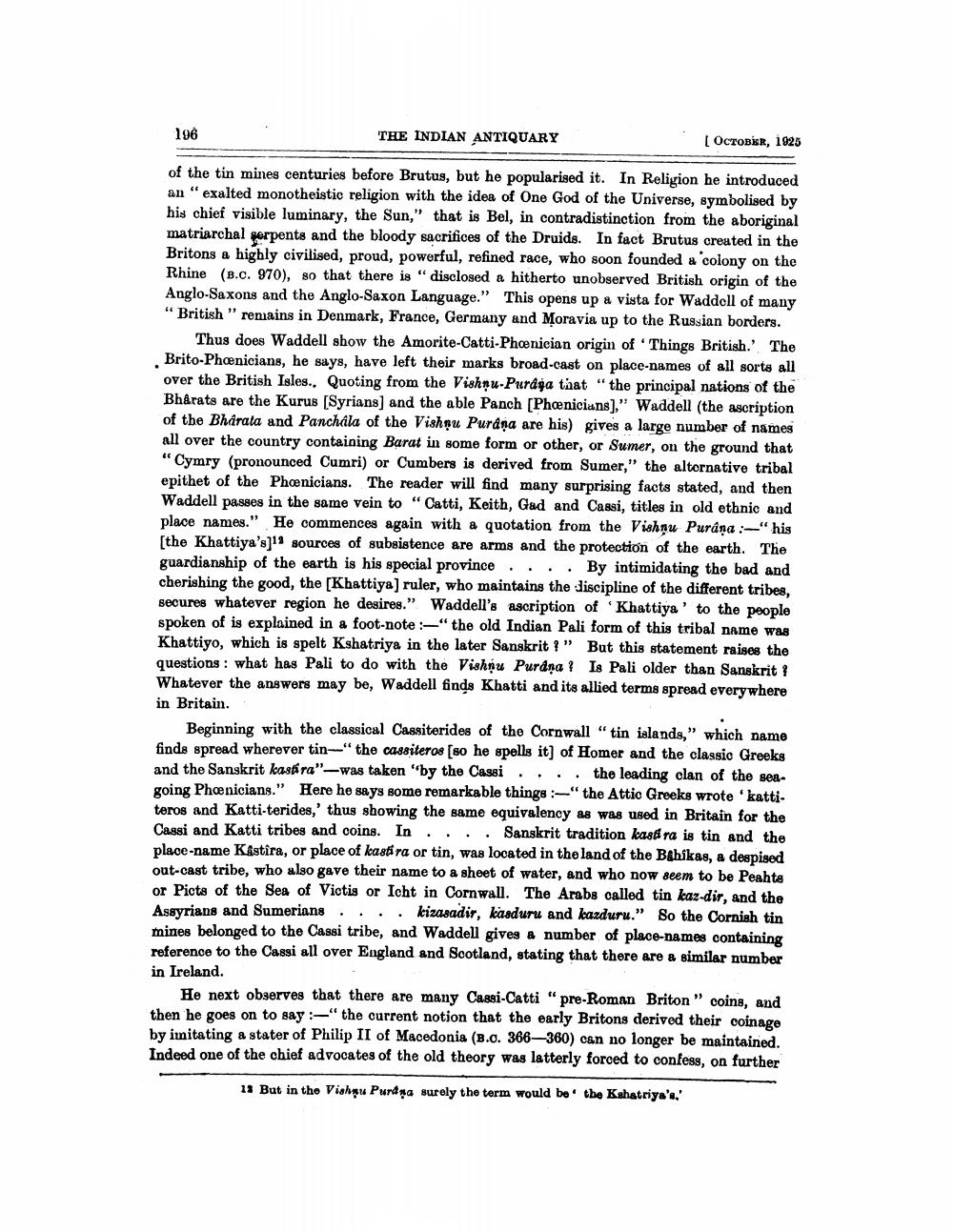________________
196
THE INDIAN ANTIQUARY
OCTOBER, 1925
of the tin mines centuries before Brutus, but he popularised it. In Religion he introduced an "exalted monotheistic religion with the idea of One God of the Universe, symbolised by his chief visible luminary, the Sun," that is Bel, in contradistinction from the aboriginal matriarchal serpents and the bloody sacrifices of the Druids. In fact Brutus created in the Britons a highly civilised, proud, powerful, refined race, who soon founded a colony on the Rhine (B.C. 970), so that there is " disclosed a hitherto unobserved British origin of the Anglo-Saxons and the Anglo-Saxon Language.” This opens up a vista for Waddell of many "British " remains in Denmark, France, Germany and Moravia up to the Russian borders.
Thus does Waddell show the Amorite-Catti-Phoenician origin of Things British.' The Brito-Phoenicians, he says, have left their marks broad-cast on place-names of all sorts all over the British Isles.. Quoting from the Vishnu-Purana that "the principal nations of the Bharats are the Kurus (Syrians) and the able Panch [Phænicians]," Waddell (the ascription of the Bharata and Panchala of the Vishņu Purana are his) gives a large number of names all over the country containing Barat in some form or other, or Sumer, on the ground that "Cymry (pronounced Cumri) or Cumbers is derived from Sumer," the alternative tribal epithet of the Phoenicians. The reader will find many surprising facts stated, and then Waddell passes in the same vein to “Catti, Keith, Gad and Cassi, titles in old ethnic and place names." He commences again with a quotation from the Vishnu Purana :-" his [the Khattiya's]1 sources of subsistence are arms and the protection of the earth. The guardianship of the earth is his special province.... By intimidating the bad and cherishing the good, the [Khattiya) ruler, who maintains the discipline of the different tribes, secures whatever region he desires." Waddell's ascription of Khattiya' to the people spoken of is explained in a foot-note :-" the old Indian Pali form of this tribal name was Khattiyo, which is spelt Kshatriya in the later Sanskrit ?" But this statement raises the questions: what has Pali to do with the Vishnu Purana ? Is Pali older than Sanskrit ? Whatever the answers may be, Waddell finds Khatti and its allied terms spread everywhere in Britain.
Beginning with the classical Cassiterides of the Cornwall "tin islands," which name finds spread wherever tin-"the cassiteros [so he spells it) of Homer and the classic Greeks and the Sanskrit kastara"-was taken by the Cassi.. . the leading clan of the seagoing Phoenicians." Here he says some remarkable things -"the Attic Greeks wrote 'katti. teros and Katti-terides,' thus showing the same equivalency as was used in Britain for the Cassi and Katti tribes and coins. In ..Sanskrit tradition kastra is tin and the place-name Kastîra, or place of kasti ra or tin, was located in the land of the Bahikas, a despised out-cast tribe, who also gave their name to a sheet of water, and who now seem to be Peahte or Picts of the Sea of Victis or Icht in Cornwall. The Arabs called tin kaz-dir, and the Assyrians and Sumerians ... kizasadit, kasduru and karduru." So the Cornish tin mines belonged to the Cassi tribe, and Waddell gives a number of place-names containing reference to the Cassi all over England and Scotland, stating that there are & similar number in Ireland.
He next observes that there are many Cassi-Catti "pre-Roman Briton" coins, and then he goes on to say "the current notion that the early Britons derived their coinage by imitating a stater of Philip II of Macedonia (B.O. 366-360) can no longer be maintained. Indeed one of the chief advocates of the old theory was latterly forced to confess, on further
13 But in the Vishnu Purana surely the term would be the Kshatriya's.'




